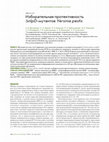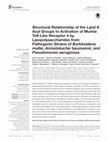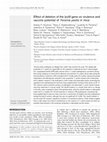Papers by Rima Shaikhutdinova
Advanced Science Letters, Dec 1, 2008
Achievements in the Life Sciences, 2016

Acta Naturae, 2015
It has recently been shown that the NlpD lipoprotein is essential to Yersinia pestis virulence an... more It has recently been shown that the NlpD lipoprotein is essential to Yersinia pestis virulence and that subcutaneous administration of the nlpD mutant could protect mice against bubonic and pneumonic plague better than the EV vaccine strain [PLoS One 2009. V. 4. № 9. e7023]. In this study, similar nlpD mutants were generated on the basis of other Y. pestis parent strains, including strains from the subspecies microtus, which is avirulent to guinea pigs and humans. Comparative testing confirmed that immunization of mice with nlpD mutants induces immunity 105 times more potent than the one induced by the administration of the EV vaccine strain. At the same time, NlpD- bacteria failed to protect guinea pigs in the case of a subcutaneous challenge with Y. pestis, inducing a 106 times less potent protection compared with that conferred by immunization with the EV vaccine strain. The possible causes of the observed phenomena are discussed.
Problems of Particularly Dangerous Infections, 2012
Проведена сравнительная оценка вирулентности представителей рода Photorhabdus (семейство Enteroba... more Проведена сравнительная оценка вирулентности представителей рода Photorhabdus (семейство Enterobacteriaceae), отличающихся по патогенности для человека, в отношении мышей при подкожном (п/к) и внутрибрюшинном (в/б) заражении. Показано, что исключительно энтомопатогенный штамм P. temperata subsp. cinerea 3107 T авирулентен для мышей линии BalB/c (lD 50 п/к > 10 8 КОЕ, lD 50 в/б > 10 8 КОЕ), а гибель лабораторных животных вызывают только бактерии вида P. asymbiotica, выделенные от больных людей: subsp.
Carbohydrate research, Jan 2, 2018
Lipopolysaccharide was isolated from bacteria Yersinia intermedia H9-36/83 (O:17) and degraded wi... more Lipopolysaccharide was isolated from bacteria Yersinia intermedia H9-36/83 (O:17) and degraded with mild acid to give an O-specific polysaccharide, which was isolated by GPC on Sephadex G-50 and studied by sugar analysis and 1D and 2D NMR spectroscopy. The polysaccharide was found to contain 3-deoxy-3-[(R)-3-hydroxybutanoylamino]-d-fucose (d-Fuc3NR3Hb) and the following structure of the heptasaccharide repeating unit was established: The structure established is consistent with the gene content of the O-antigen gene cluster. The O-polysaccharide structure and gene cluster of Y. intermedia are related to those of Hafnia alvei 1211 and Escherichia coli O:103.
Carbohydrate Research, 2017
An O-polysaccharide was isolated from the lipopolysaccharide of an entomopathogenic bacterium Yer... more An O-polysaccharide was isolated from the lipopolysaccharide of an entomopathogenic bacterium Yersinia entomophaga MH96 T by mild acid hydrolysis and studied by 2D NMR spectroscopy. The following structure of the branched tetrasaccharide repeating unit of the polysaccharide was established: where Tyv indicates 3,6-dideoxy-D-arabino-hexose (tyvelose). The structure established is consistent with the gene content of the O-antigen gene cluster. The O-polysaccharide structure and gene cluster of Y. entomophaga are related to those of some Y. pseudotuberculosis serotypes.

Frontiers in Immunology, 2015
Toll-like receptor 4 (TLR4) is required for activation of innate immunity upon recognition of lip... more Toll-like receptor 4 (TLR4) is required for activation of innate immunity upon recognition of lipopolysaccharide (LPS) of Gram-negative bacteria. The ability of TLR4 to respond to a particular LPS species is important since insufficient activation may not prevent bacterial growth while excessive immune reaction may lead to immunopathology associated with sepsis. Here, we investigated the biological activity of LPS from Burkholderia mallei that causes glanders, and from the two well-known opportunistic pathogens Acinetobacter baumannii and Pseudomonas aeruginosa (causative agents of nosocomial infections). For each bacterial strain, R-form LPS preparations were purified by hydrophobic chromatography and the chemical structure of lipid A, an LPS structural component, was elucidated by HR-MALDI-TOF mass spectrometry. The biological activity of LPS samples was evaluated by their ability to induce production of proinflammatory cytokines, such as IL-6 and TNF, by bone marrow-derived macrophages. Our results demonstrate direct correlation between the biological activity of LPS from these pathogenic bacteria and the extent of their lipid A acylation.
Carbohydrate research, Jan 30, 2015
A phosphorylated O-polysaccharide was isolated from the lipopolysaccharide of an entomopathogenic... more A phosphorylated O-polysaccharide was isolated from the lipopolysaccharide of an entomopathogenic bacterium Photorhabdus temperata subsp. cinerea 3240 and studied by sugar analysis, dephosphorylation, and (1)H and (13)C NMR spectroscopy. The following structure of the linear trisaccharide repeating unit of the O-polysaccharide was established: →3)-β-d-GalpNAc4PEtN-(1→4)-β-d-GlcpA-(1→3)-β-d-FucpNAc4N-(1→ where GlcA indicates glucuronic acid, FucNAc4N 2-acetamido-4-amino-2,4,6-trideoxygalactose, and PEtN 2-aminoethyl phosphate.
ABSTRACT Pathogenicity of the causative agent of plague, the bacterium Yersinia pestis, is determ... more ABSTRACT Pathogenicity of the causative agent of plague, the bacterium Yersinia pestis, is determined by a number of factors including a rough-type lipopolysaccharide (LPS) (Skurnik et al., 2000), which mediates serum and cationic-antimicrobial-peptides resistance as well as infective toxic shock (Perry and Fetherston, 1997). Elucidation of the chemical structure of the LPS may usher in a new era in understanding pathogen-host interactions on the molecular level. Here we report on the full structure of the core region of Y. pestis LPS and the influence of growth temperature on the core structure.
Disruption of lipopolysaccharide (LPS) biosynthesis genes in an epidemiologically significant Yer... more Disruption of lipopolysaccharide (LPS) biosynthesis genes in an epidemiologically significant Yersinia pestis strain showed that the ability to synthesize the full inner core of the LPS is crucial for resistances to the bactericidal action of antimicrobial peptides and to complement-mediated serum killing. Resistance to polymyxin B also requires a high content of the cationic sugar, 4-amino-4-deoxy-L-arabinose, in lipid A.
Open access under CC BY-NC-ND license.
... P. Anisimov, Svetlana V. Dentovskaya, Anna N. Kondakova, Buko Lindner, Rima Z. Shaikhutdinova... more ... P. Anisimov, Svetlana V. Dentovskaya, Anna N. Kondakova, Buko Lindner, Rima Z. Shaikhutdinova, Nina A. Kocharova, Sof'ya N. Senchenkova, and Yuriy A. Knirel ... to 1 cfu, five mice for one dose; 104 to 101 cfu, three guinea pigs for one dose, respectively) of 2-day Y. pestis ...
The live plague vaccine strain Yersinia pestis EV line NIIEG, a well-known derivative of an atten... more The live plague vaccine strain Yersinia pestis EV line NIIEG, a well-known derivative of an attenuated pigmentation-negative strain Y. pestis EV76, has been widely used for human and animal immunization in Russia and the FSU countries. The main advantage of the EV NIIEG is its ability to induce rapidly a high level of specific immunity against both bubonic and pneumonic
Vaccine, 2009
This article appeared in a journal published by Elsevier. The attached copy is furnished to the a... more This article appeared in a journal published by Elsevier. The attached copy is furnished to the author for internal non-commercial research and education use, including for instruction at the authors institution and sharing with colleagues. Other uses, including reproduction and distribution, or selling or licensing copies, or posting to personal, institutional or third party websites are prohibited. In most cases authors are permitted to post their version of the article (e.g. in Word or Tex form) to their personal website or institutional repository. Authors requiring further information regarding Elsevier's archiving and manuscript policies are encouraged to visit:
Vaccine, 2007
The lpxM mutant of the live vaccine Yersinia pestis EV NIIEG strain synthesising a less toxic pen... more The lpxM mutant of the live vaccine Yersinia pestis EV NIIEG strain synthesising a less toxic penta-acylated lipopolysaccharide was found to be avirulent in mice and guinea pigs, notably showing no measurable virulence in Balb/c mice which do retain some susceptibility to the parental strain itself. Twenty-one days after a single injection of the lpxM-mutant, 85-100% protection was achieved in outbred mice and guinea pigs, whereas a 43% protection rate was achieved in Balb/c mice given single low doses (10 3 to 2.5 × 10 4 CFU) of this vaccine. A subcutaneous challenge with 2000 median lethal doses (equal to 20,000 CFU) of fully virulent Y. pestis 231 strain, is a 6-10-fold higher dose than that which the EV NIIEG itself can protect against.

Journal of Medical Microbiology, 2007
Yersinia pestisundergoes an obligate flea–rodent–flea enzootic life cycle. The rapidly fatal prop... more Yersinia pestisundergoes an obligate flea–rodent–flea enzootic life cycle. The rapidly fatal properties ofY. pestisare responsible for the organism's sustained survival in natural plague foci. Lipopolysaccharide (LPS) plays several roles inY. pestispathogenesis, prominent among them being resistance to host immune effectors and induction of a septic-shock state during the terminal phases of infection. LPS is acylated with 4–6 fatty acids, the number varying with growth temperature and affecting the molecule's toxic properties.Y. pestismutants were constructed with a deletion insertion in thelpxMgene in both virulent and attenuated strains, preventing the organisms from synthesizing the most toxic hexa-acylated lipid A molecule when grown at 25 °C. The virulence and/or protective potency of pathogenic and attenuatedY. pestisΔlpxMmutants were then examined in a mouse model. The ΔlpxMmutation in a virulent strain led to no change in the LD50value compared to that of the parenta...
Carbohydrate Research, 2008
Structures of the O-antigens of Yersinia pseudotuberculosis O2c and O3 were reinvestigated by NMR... more Structures of the O-antigens of Yersinia pseudotuberculosis O2c and O3 were reinvestigated by NMR spectroscopy, including 2D (1)H,(1)H COSY, TOCSY, ROESY, (1)H,(13)C HSQC, and HMBC experiments. The following revised structure of the O2c tetrasaccharide repeating unit was established, which differs from the structure proposed earlier in the glycosylation pattern of the mannose residue at the branching point: [carbohydrate structure: see text] where Abe stands for 3,6-dideoxy-d-xylo-hexose. The structure of the Y. pseudotuberculosis O3 antigen reported earlier was confirmed.

Carbohydrate Research, 2005
Following a report of variations in the lipopolysaccharide (LPS) structure of Yersinia pestis at ... more Following a report of variations in the lipopolysaccharide (LPS) structure of Yersinia pestis at mammalian (37 degrees C) and flea (25 degrees C) temperatures, a number of changes to the LPS structure were observed when the bacterium was cultivated at a temperature of winter-hibernating rodents (6 degrees C). In addition to one of the known Y. pestis LPS types, LPS of a new type was isolated from Y. pestis KM218 grown at 6 degrees C. The core of the latter differs in: (i) replacement of terminal galactose with terminal d-glycero-d-manno-heptose; (ii) phosphorylation of terminal oct-2-ulosonic acid with phosphoethanolamine; (iii) a lower content of GlcNAc, and; (iv) the absence of glycine; lipid A differs in the lack of any 4-amino-4-deoxyarabinose and presumably partial (di)oxygenation of a fatty acid(s). The data obtained suggest that cold temperature switches on an alternative mechanism of control of the synthesis of Y. pestis LPS.
Carbohydrate Research, 2009
The O-specific polysaccharide was isolated by mild acid degradation of the lipopolysaccharide of ... more The O-specific polysaccharide was isolated by mild acid degradation of the lipopolysaccharide of Yersinia pseudotuberculosis O:4a and studied by NMR spectroscopy, including 2D ROESY and (1)H, (13)C HMBC experiments. The following structure of the pentasaccharide repeating unit of the polysaccharide was established, which differs from the structure reported earlier [Gorshkova, R. P. et al., Bioorg. Khim. 1983, 9, 1401-1407] in the linkage modes between the monosaccharides: [carbohydrate sequence see in text] where Tyv stands for 3,6-dideoxy-D-arabino-hexose (tyvelose). The structure of the Y. pseudotuberculosis O:4a antigen resembles that of Y. pseudotuberculosis O:2c, which differs in the presence of abequose (3,6-dideoxy-D-xylo-hexose) in place of tyvelose only.









Uploads
Papers by Rima Shaikhutdinova